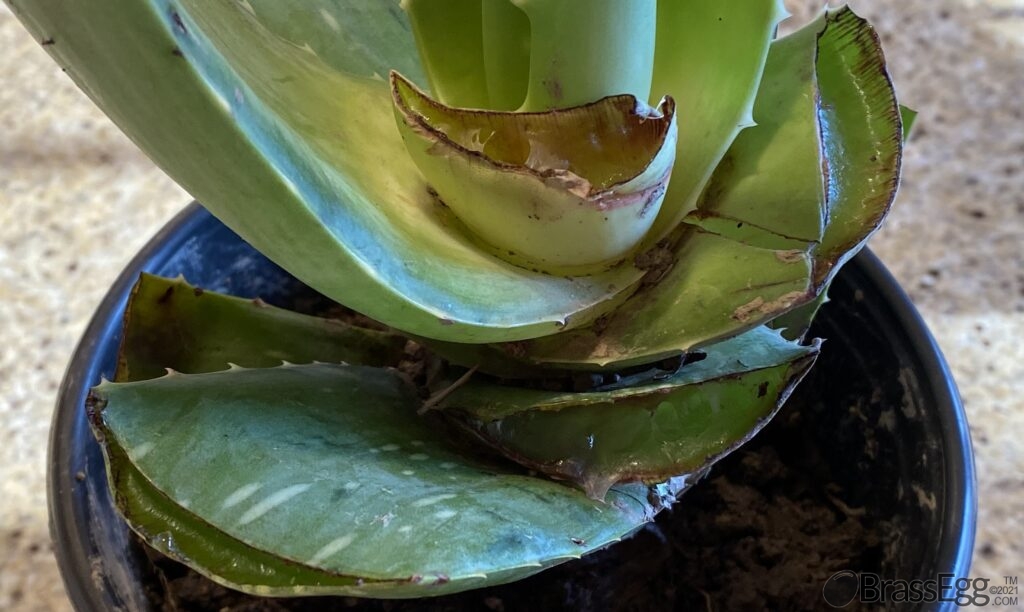There are lots of articles about how to use Aloe and how to propagate more plants, but I’ve yet to find how to rehab one. I’ve killed my share in the past, and I want to learn the secrets. It would be special to give my grandkids the aloe my mom and dad used when I was a kid. I need to quit messing up so much before risking another one of my dad’s original ones.

I’ve already killed three aloes from my mom and one from the local garden club. I picked the latest one up at a big-box store so no one would give me that disappointed look when they asked how it was doing. It was growing fine all summer. It had survived the early Spring inside, slowly been adjusted to direct sunlight while the Greenhouse was being built over the summer and then moved into a 5 gallon pot the morning I broke my leg. Then I forgot about it completely. It grew very large in direct summer sun.

The week before Thanksgiving, fall frosts began to kill back the tomatoes and the aloe began to succumb. The bright green spears where turning dark, limp, even mushy where they had frozen overnight and burst open the cell walls. I had already pulled the Rosemary out of it’s pot and threw it into a bag. Grabbing the Aloe and yanking it by the stem wasn’t an option, so I thought I would tip it out of it’s pot. I misjudged and the whole plant slipped out with a sickening ‘crunch’….three feet from where I broke my leg. Hope my garden isn’t bad luck!
All the major spears where broken in various ways. I had remembered that as a kid the plant wanted to heal straight across cuts. In other words, the spear always ‘died back’ to the point of damage closest to the base. So I trimmed all the damaged spears straight across with a butter knife.

My dad always made a point to only harvest one spear at a time. He wouldn’t break a tip off this one, then break a tip off that one. My dad was a regular user of Aloe for cuts and burns, so the spike he chose would eventually be completely used up. I just thought Dad was tidy.

When the broken edges began to dry up I wasn’t concerned. When they began to seal shut on their own I thought that would be the end of it.

When the edges turned pink I figured it was close to being done. The assumption was that each broken spear would stay plump and we could just harvest them the next sunburn that came along.

It turns out, that any damaged spike continues to die back to the base until it dries up and falls off. I could have saved myself two repottings by simply trimming off all the damaged spikes the day I crunched it.

Within 20 days it was obvious that all the broken spears would slowly dry up and rot off. Another 4 weeks went by to get photos to prove the theory.

Before repotting for the third time, every damaged spear had to be trimmed off. This time I used a paring knife to get a closer trim near the stem/root.


The Aloe had to be set nearly 4 inches deeper than it had grown in the full sun of the garden after all the damaged spears were removed.

The only undamaged spears from the original “crunch” are now gangly and unbalanced.

The roots of this Aloe are shallow and sparse. Four inches of space had to be found so it could be planted deeper, so as much dirt (clay) as possible had to be removed. While teasing the clay out of the roots I discovered two earthworms.



There is no male/female with earthworms, so it only takes two to start making babies. The Aloe will be moved back to the farm in 3 months, so it isn’t a problem to have them live rent free for awhile. I put the breeding pair together and added some coffee grounds as food. That should hold them for a while based on what I’ve read about vermiculture.




Simply splitting open the aloe and using a butter knife to cut the gel free from the skin in one long and wide ‘fillet’ makes it easy to stack Aloe into a zip-lock bag and freeze it for future use. Aloe ‘fillets’ freeze well and give soothing relief from sunburn or acne breakout.

The Mayo Clinic recognizes topical sunburn, acne and psoriasis uses for Aloe, but warns against ingesting it in it’s ‘unprocessed’ form because it damages the kidneys. My dad ended up on dialysis the last years of his life, so the fact he drank Aloe Juice may have been a contributing factor.

Our doctor recommended a processed Aloe pill for my husband, but you aren’t supposed to use it every day. I’ve included the directions and warnings here. I’m not a doctor of medicine and this isn’t medical advice. All I can say is my husband likes this and it works when other products haven’t.

The new growth will come from the center and in time the Aloe will fill out. Next year the Aloe will start in the greenhouse even before frosts are over. It should grow very large by next winter after a summer of sun at the farm.
Brass Egg™ participates in affiliate marketing programs, and may receive compensation when you click and purchase from links to retailers. Brass Egg™ of Russell Holdings Group, LLC 2021. All content ©2021 Russell Illinois Holdings, LLC. All Rights Reserved.





















